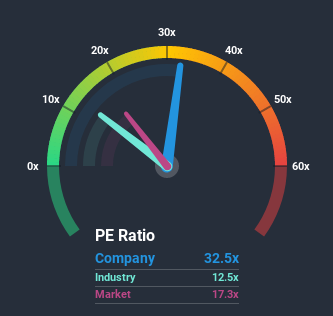Unpleasant Surprises Could Be In Store For Western Pacific Trust Company's (CVE:WP) Shares
With a price-to-earnings (or "P/E") ratio of 32.5x Western Pacific Trust Company (CVE:WP) may be sending very bearish signals at the moment, given that almost half of all companies in Canada have P/E ratios under 17x and even P/E's lower than 9x are not unusual. However, the P/E might be quite high for a reason and it requires further investigation to determine if it's justified.
Recent times have been quite advantageous for Western Pacific Trust as its earnings have been rising very briskly. The P/E is probably high because investors think this strong earnings growth will be enough to outperform the broader market in the near future. You'd really hope so, otherwise you're paying a pretty hefty price for no particular reason.
View our latest analysis for Western Pacific Trust
Although there are no analyst estimates available for Western Pacific Trust, take a look at this free data-rich visualisation to see how the company stacks up on earnings, revenue and cash flow.
Does Growth Match The High P/E?
The only time you'd be truly comfortable seeing a P/E as steep as Western Pacific Trust's is when the company's growth is on track to outshine the market decidedly.
Retrospectively, the last year delivered an exceptional 274% gain to the company's bottom line. Still, EPS has barely risen at all from three years ago in total, which is not ideal. Accordingly, shareholders probably wouldn't have been overly satisfied with the unstable medium-term growth rates.
This is in contrast to the rest of the market, which is expected to grow by 20% over the next year, materially higher than the company's recent medium-term annualised growth rates.
In light of this, it's alarming that Western Pacific Trust's P/E sits above the majority of other companies. Apparently many investors in the company are way more bullish than recent times would indicate and aren't willing to let go of their stock at any price. There's a good chance existing shareholders are setting themselves up for future disappointment if the P/E falls to levels more in line with recent growth rates.
The Final Word
It's argued the price-to-earnings ratio is an inferior measure of value within certain industries, but it can be a powerful business sentiment indicator.
We've established that Western Pacific Trust currently trades on a much higher than expected P/E since its recent three-year growth is lower than the wider market forecast. Right now we are increasingly uncomfortable with the high P/E as this earnings performance isn't likely to support such positive sentiment for long. Unless the recent medium-term conditions improve markedly, it's very challenging to accept these prices as being reasonable.
Having said that, be aware Western Pacific Trust is showing 2 warning signs in our investment analysis, you should know about.
You might be able to find a better investment than Western Pacific Trust. If you want a selection of possible candidates, check out this free list of interesting companies that trade on a P/E below 20x (but have proven they can grow earnings).
This article by Simply Wall St is general in nature. It does not constitute a recommendation to buy or sell any stock, and does not take account of your objectives, or your financial situation. We aim to bring you long-term focused analysis driven by fundamental data. Note that our analysis may not factor in the latest price-sensitive company announcements or qualitative material. Simply Wall St has no position in any stocks mentioned.
Have feedback on this article? Concerned about the content? Get in touch with us directly. Alternatively, email editorial-team (at) simplywallst.com.

 Yahoo Finance
Yahoo Finance 
